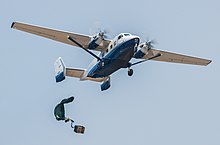
The Lockheed MC-130 is the basic designation for a family of special mission aircraft operated by the United States Air Force Special Operations Command (AFSOC), a wing of the Air Education and Training Command, and an AFSOC-gained wing of the Air Force Reserve Command. Based on the Lockheed C-130 Hercules transport, the MC-130s' missions are the infiltration, exfiltration, and resupply of special operations forces, and the air refueling of (primarily) special operations helicopter and tilt-rotor aircraft.

Air Force Special Operations Command (AFSOC), headquartered at Hurlburt Field, Florida, is the special operations component of the United States Air Force. An Air Force major command (MAJCOM), AFSOC is also the U.S. Air Force component command to United States Special Operations Command (USSOCOM), a unified combatant command located at MacDill Air Force Base, Florida. AFSOC provides all Air Force Special Operations Forces (SOF) for worldwide deployment and assignment to regional unified combatant commands.
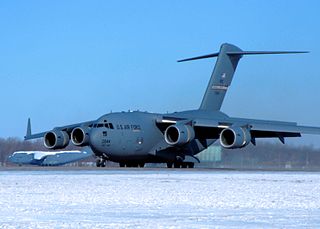
The 445th Airlift Wing is an Air Reserve Component of the United States Air Force. It is assigned to the Fourth Air Force, Air Force Reserve Command, stationed at Wright-Patterson Air Force Base, Ohio. If mobilized, the wing is gained by the Air Mobility Command.

Duke Field, also known as Eglin AFB Auxiliary Field #3, is a military airport located three miles (5 km) south of the central business district of Crestview, in Okaloosa County, Florida, United States.

The 440th Airlift Wing is an inactive United States Air Force Reserve unit last assigned to Twenty-Second Air Force. It was last stationed at Pope Army Airfield, part of Fort Bragg in North Carolina.

The 927th Air Refueling Wing is an Air Reserve Component (ARC) unit of the United States Air Force. It is assigned to the Fourth Air Force of Air Force Reserve Command (AFRC) and is stationed at MacDill Air Force Base, Florida.

The 940th Air Refueling Wing is part of the Air Reserve Component of the United States Air Force. It is assigned to the Fourth Air Force of the Air Force Reserve Command, is operationally-gained by the Air Mobility Command, and is home stationed at Beale Air Force Base, California.

The 459th Air Refueling Wing is a wing of the Air Force Reserve Command of the United States Air Force. It is assigned to the Fourth Air Force and stationed at Joint Base Andrews, Maryland. If mobilized, the wing would be gained by the Air Mobility Command. The wing flies and maintains Boeing KC-135 Stratotankers, providing air refueling.
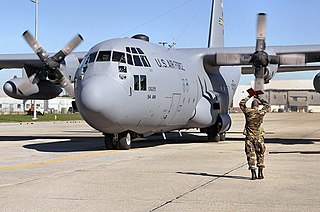
The 94th Airlift Wing is a reserve unit of the United States Air Force. It is assigned to the Twenty-Second Air Force of the Air Force Reserve Command (AFRC) and is stationed at Dobbins Air Reserve Base, Georgia. When mobilized, most of the wing would be presented to US Transportation Command, while a smaller proportion would be retained by AFRC.
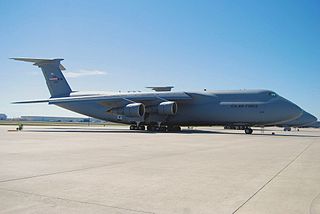
The 433rd Airlift Wing, sometimes written as 433d Airlift Wing, is an Air Reserve component of the United States Air Force. It is assigned to Fourth Air Force, Air Force Reserve Command, stationed at Kelly Field Annex, Joint Base San Antonio, Texas. If mobilized, the wing is gained by Air Mobility Command.

The 910th Airlift Wing is an Air Force reserve unit, stationed at Youngstown Air Reserve Station, Ohio. It flies C-130H Hercules aircraft on airlift and aerial spray missions. The wing maintain the DoD’s only large area fixed-wing aerial spray capability to control disease-carrying insects, pest insects, undesirable vegetation and to disperse oil spills in large bodies of water using six C-130H aircraft equipped with the Modular Aerial Spray System (MASS).

The 911th Airlift Wing is an Air Mobility Command-gained unit of the Air Force Reserve Command (AFRC), based out of Pittsburgh Air Reserve Station at the Pittsburgh International Airport, Pennsylvania.

The 913th Airlift Group is a United States Air Force Reserve unit. It is assigned to 22d Air Force and is stationed at Little Rock Air Force Base, Arkansas. It was activated 13 July 2014.

The 920th Rescue Wing is part of the Air Reserve Component (ARC) of the United States Air Force. The wing is assigned to the Tenth Air Force of the Air Force Reserve Command (AFRC).

The 934th Airlift Wing is an Air Reserve Component of the United States Air Force. It is assigned to Twenty-Second Air Force, Air Force Reserve Command (AFRC) and is stationed at Minneapolis-St Paul Joint Air Reserve Station, Minnesota.

The 5th Special Operations Squadron is part of the 919th Special Operations Wing. The 5th is based at Hurlburt Field, Florida. It operates U-28 aircraft providing special operations capability.
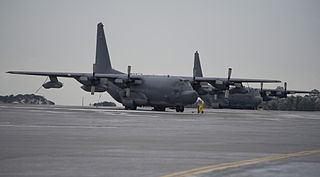
The 19th Special Operations Squadron is an Air Force Special Operations Command unit, part of the 492nd Special Operations Wing at Hurlburt Field, Florida. It conducts crew training for AC-130 and Lockheed MC-130 aircraft.

The 71st Special Operations Squadron is part of the 58th Special Operations Wing at Kirtland Air Force Base, New Mexico. It operates Bell Boeing CV-22 Osprey conducting special operations flying training.

The 711th Special Operations Squadron is an active reserve squadron of the United States Air Force, part of the 919th Special Operations Wing at Duke Field, Florida. The unit isoperationally gained by Air Force Special Operations Command if called to active duty.
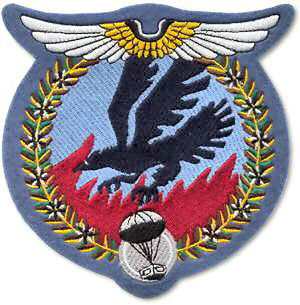
The 67th Troop Carrier Squadron is an inactive United States Air Force unit. It was last assigned to the 433d Troop Carrier Group, based at Rhein-Main Air Base, West Germany. It was inactivated on July 14, 1952.




